This has been built with YOU in mind!
We invite you to come walk the labyrinth when you are visiting Orcas Island
- If you have walked Emmanuel’s Labyrinth, please take a moment to sign our guestbook and tell us about your experience!
- If you’d like to comment on what you see on this page, please scroll to the bottom and add your thoughts. Thank you!!
Interested in labyrinths? – We are too! – You’ll find it all right here!
Walking a Labyrinth
Labyrinth Facts
Labyrinth Resources
Books to browse
Scriptures to think on
Blessing of the Land
Our Earlier Temporary Labyrinth
Upcoming Labyrinth Activities
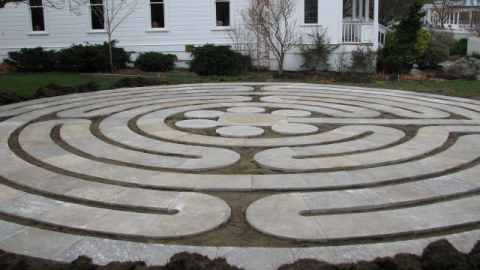
Photo taken just after stones for the permanent labyrinth were placed – Feb. 2011
Click here to learn more about the making of Emmanuel’s Labyrinth
Walking a Labyrinth
“There are two main ways to use the labyrinth: meditative walking and ritual or ceremonial use.
The four areas the labyrinth can address are:
Healing (specifically psycho-spiritual healing), Self-Knowledge (now called Shadow Work), and Co-creation (now called Soul Assignment), and Initiation.
Initiatory rituals, or ceremonial use, are becoming a popular way to use the labyrinth. They are effective in helping us move through important transitions in our lives. A person going through a divorce may walk it on the day she/he receives final legal papers. Or an employee may walk it on the first day of a new job. Many share a ritual experience with their community of friends on 16th birthdays, or graduations, or weddings or for women when they become (sometime in their second half of life, usually over 50) crones (wise women). Many labyrinth enthusiasts are creating ceremonies that mark the turning of the seasons and other rites of passage that smooth the way for life’s transitions.”
From: “Walking a Sacred Path: Rediscovering the labyrinth as a spiritual practice” – Lauren Artress
Labyrinth Facts
According to the World-Wide Labyrinth Locator sponsored by Veriditas* and the Labyrinth Society, there are 75 labyrinths in the state of Washington. The probability is that there are many more that have not been registered.
There are 44 found in conference centers, museums, schools, public parks, hospitals, and private gardens. There are 10 people who travel with canvas labyrinths. The Army Corps of Engineers has a labyrinth in Bridgeport.
There are 30 labyrinths found in churches, with the majority found in Episcopal churches.
The breakdown for churches is as follows:
Episcopal – 14
Unity – 4
Lutheran – 3
Congregational – 3
Methodist – 1
Catholic – 1
Baptist – 1
Community Church, Seattle – 1
Christian Church – 1
Center for Spiritual Living – 1
*VERIDITAS – a word first coined by 12th century Catholic Nun, visionary, and mystic Hildegard von Bingen. It means a greening of the soul, a renewal, a rebirth – in short, a change for the better.
• The vision of Veriditas, The World-Wide Labyrinth Project, is to activate and facilitate the transformation of the Human Spirit. Veriditas’ work to transform the Human Spirit centers around the Labyrinth Experience as a personal practice for healing and growth, a tool for community building, an agent for global peace and a metaphor for the blossoming of the Spirit in our lives. Veriditas offers events in the United States and the annual Walking a Sacred Path program at Chartres Cathedral in France.
• Veriditas – Veriditas, The Voice of the Labyrinth Movement, was founded in 1996 by Lauren Artress, and is a non-profit organization dedicated to introducing people to the healing, meditative powers of the labyrinth.
Check out these great resources:
- Interviews and Articles
- Veriditas
- Books about the labyrinth
- List of labyrinths in Washington State
- Labyrinth Network Northwest
- A complete list about labyrinths
- Grace Cathedral and the labyrinths.
- A virtual lesson on how to draw a labyrinth
- The Chartres Cathedral labyrinth
- The Numerology of the Chartres Cathedral labyrinth
- Labyrinth and alzheimers.
Books to browse:
Scriptures to think on:
Blessing of the Land
“To Bless the Sacred Circle”
Emmanuel Episcopal Land Blessed for Labyrinth
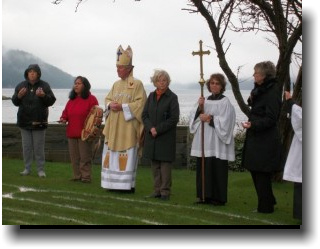
Honoring the land — a permanent labyrinth will be constructed on the waterfront land of Emmanuel Episcopal Church.
Pictured left to right are: Betty Hall, Rosie Cayou James, Bishop Craig Anderson, Heidi Hudlet, Luann Pamatian and Nancy Ayer
“My father was born here, went to school in Deer Harbor. We are here to honor the land of our ancestors. We are all different, beautiful flowers of the Master’s bouquet. My grandfather taught me that white people are the beautiful color of the blackberry blossom. My people knew not envy, not hatred, not arrogance.” -Rosie Cayou James, Samish Tribal Leader
On a windy, cold November 14 Sunday morning, the rain held off and the lawn at Emmanuel Church lay witness to an ancient ceremony.
Rosie Cayou James, her husband Bill Bailey, leaders of the Samish Tribe, along with Rosie’s cousin, Orcas Islander and tribal member, Betty Hall, led Emmanuel Parish and guests in a blessing of the land where a permanent community labyrinth will be built.
Emmanuel’s rector, Bishop Craig Anderson, also played an important part in the ceremony. Bishop Craig served as a former bishop of South Dakota where 75 of the 109 churches in the Diocese are on the reservations of the Great Sioux Nation. He learned the language and the culture and was adopted by the Oglala Tribe. It is important to Native Americans to consecrate the land, held sacred by them for generations, prior to the commencement of construction of another sacred site.
In so blessing the land the Samish were asking the ancestors for permission. It was also important to the tribal leaders that this blessing be kept as low-key as possible with members attending last Sunday’s blessing were Emmanuel Parishioners, visitors to the church for that day, and key people involved in the labyrinth construction process involved in the ceremony.
There will be a large blessing and completion ceremony held the end of May. At that time, the Orcas community will be invited to join with Emmanuel Parish and the Samish and Lummi for yet another joyful celebration.
Samish leaders bless the land for the permanent labyrinth – Nov. 14th, 2010
As the clouds gathered last Sunday, so did the people, filling in around the outside edge of the temporary, painted labyrinth. Each person present dipped a cedar bough into a bowl of holy water to bless and add their energy to this most sacred space. It was a moving experience to observe the land imbued with so many powerful forces.
It’s been many generations, if ever, that Orcas Island has witnessed the merging of spiritual leaders from different cultures joining with the common goal of honoring each other and the ancient land. History was made last Sunday and permission granted by the ancestors to build a sacred space on top of another sacred space, repeating an act as old as the human race.
“The Creator knows that each and every one of you is in one sacred circle today. Believe in your vision. The young ones are witnesses of this work. Go home and document this day with your memories. That’s what keeps this alive today. The Creator recognizes the heart and soul of believers. That’s what brings us all into this circle.”
Rosie Cayou James
– Nancy Ayer
Before the permanent stone labyrinth was in place, there was……..
THE “LABYRINTH ON THE LAWN”
SUMMER 2010
A HIT WITH RESIDENTS AND VISITORS ALIKE!
The labyrinth committee offered the labyrinth experience to the entire Orcas community. The labyrinth serves as an ecumenical bridge connecting all faiths, cultures and beliefs to the One great God, to the Unity and Oneness of our universe.
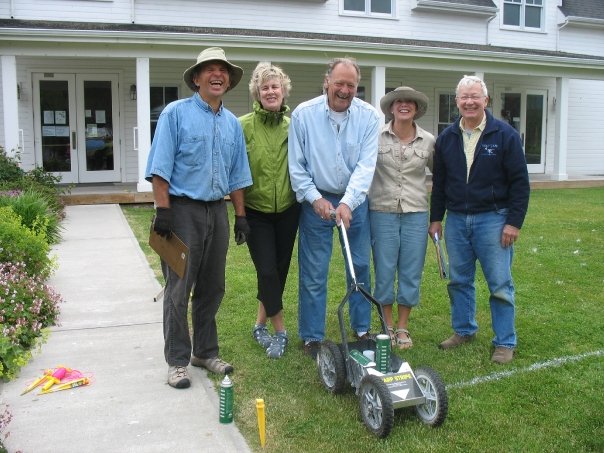
The crew laid out the temporary lime labyrinth on the lawn between the church and Parish Hall in preparation for last Sunday’s
“Labyrinth on the Lawn”. The Garden Gang had just been in to help make everything look beautiful and the weather was wonderful for the event! The walk was open to the community and was very well attended.
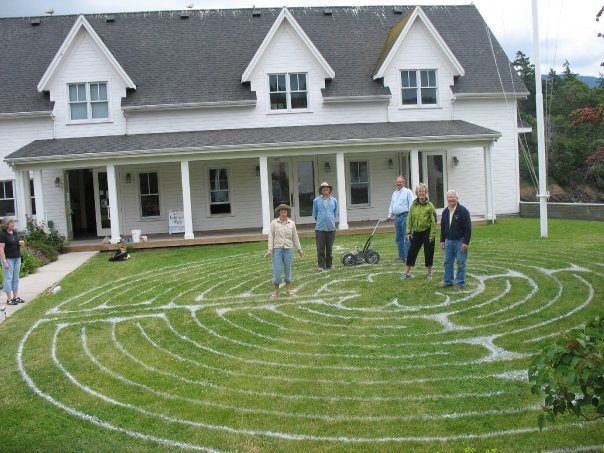
<
The labyrinth committee offers the labyrinth experience to the entire Orcas community.
Emmanuel’s Temporary Outdoor Labyrinth
This labyrinth is called an 11 circuit Chartres labyrinth. It is an exact copy of the ancient labyrinth built in 1201 which may still be found in Chartres Cathedral, outside Paris, France. Ancient pilgrims walked the Chartres labyrinth. When the dangers of the day made it impossible for pilgrims to make the trek to Jerusalem, they would seek God by walking the Chartres labyrinth. The center of the labyrinth was often called “The New Jerusalem”.
Emmanuel’s former temporary labyrinth – Photo by Cheryl Hunnicutt Danskin
“Labyrinths are powerful blueprints that order chaos, offer a path of prayer, heal deep wounds, serve as a place of solace, and transform human consciousness, individually and in community.” The Rev. Lauren Artress.



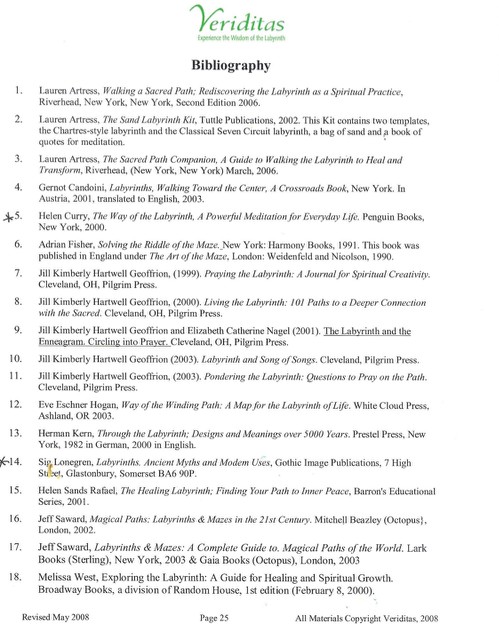



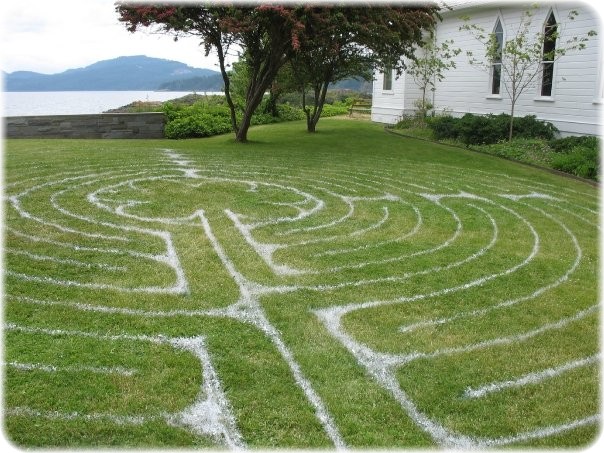
0 Comments